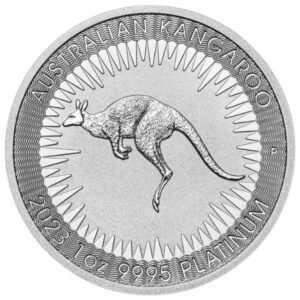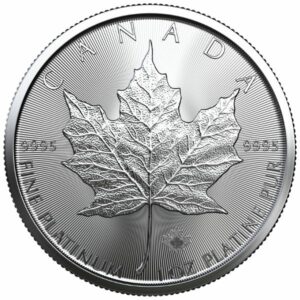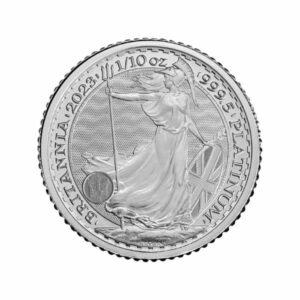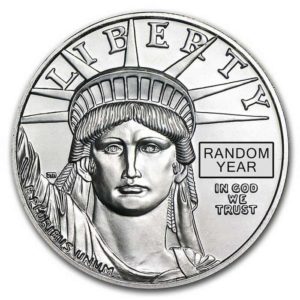A Brief History of Platinum Coins

For decades, platinum coins have been a major tool for stackers looking to diversify and expand their growing precious metal portfolios. While some collectors think that platinum is a modern creation, the metal’s actual history is much older. Investors who want to dive into the joys of collecting platinum bullion should understand the basics of this precious metal’s complicated history.
The history of platinum spans several hundreds of years and almost every continent on the planet. Even platinum coins have been traded for several hundreds of years. In today’s Bullion Academy guide, we’re taking a look at the exciting history of platinum coins. By the end of this page, you should be able to impress your friends with how much you know about the storied history of platinum coins.
What Are Platinum Coins?
Platinum coins are a currency that has been used by several governments throughout history. Today, platinum bullion coins are distributed by many of the world’s most popular mints. Centuries ago, actual platinum was used to facilitate trade between merchants and companies. While platinum coins today are worth quite a bit more than their face value, this wasn’t always the case. We’ll discuss the history of platinum coins as a currency later in this guide.
You should know that platinum coinage plays an important role in precious metal investment strategies. Diversification is always important. Stackers who rely too heavily on gold and silver coins might be at risk of losing their investment if the price of one metal quickly tanks.
Adding centuries-old platinum coinage to your collection can help you weather bearish markets.
What Makes Platinum Valuable?
Some metals are only with money because of their scarcity. But what makes platinum valuable? 2 main things make platinum coins valuable: scarcity and industrial demand. For savvy collectors, this is one of platinum’s major benefits. Because platinum is used in a variety of important industrial products, it tends to retain value in a way that some other precious metals might not.
Let’s take a closer look at the two reasons platinum remains such a valuable precious metal: scarcity and industrial demand.
Scarcity of Platinum
Did you know that platinum is actually rarer than gold? While gold is more expensive to invest in, that doesn’t mean it’s the rarest precious metal. In fact, scientists believe that platinum is around 30 times rarer than gold bullion. This scarcity is certainly a reason behind platinum’s value. Throughout the history of platinum coins, these products have won a reputation as some of the most cost effective ways to invest in quality precious metal.
Platinum’s Industrial Demand
But all precious metals have scarcity, right? To understand what makes platinum special, we need to take a closer look at its industrial uses. Unlike other metals, platinum is an essential component in several major technologies.
The automotive industry, electronics, dentistry equipment, and jewelry are just some of the industries that need platinum in order to thrive. Platinum’s place in the industrial sector is an important part of the recent history of platinum coins. Platinum bullion was only really used in modern electronics starting in the 20th century, but the history of platinum jewelry goes far further.
With the basics of our favorite precious metal out of the way, it’s time to take a deep dive into the history of platinum coins. It begins, of course, with the discovery of platinum.
Discovery of Platinum
The discovery of platinum is a bit more complicated than you might assume. The metal was first discovered in South America, where it was used to create artifacts. Initially, these artifacts used a clever combination of white gold and platinum. The result was a shiny metal that looked quite a bit like modern platinum bullion.
This is the discovery of modern platinum as we know it, but the metal might have a mysterious and long history before it became the metal we love today.

Ancient Origins
There’s some evidence that Ancient Egyptians were vaguely aware of what platinum is. While we’ll get into how platinum developed during the history of platinum coins, it’s important to note that the Spanish conquistadors in South America were far from the first people to notice platinum.
The Ancient Egyptians were some of the earliest players in the complex history of platinum coins. They didn’t make coins or bars out of their platinum. To the contrary, some documents suggest that the Egyptians considered platinum to be an imperfection that tainted their gold and silver jewelry and artifacts.
Platinum: What’s in a Name?
As the Spanish discovery of platinum may suggest, the name for platinum comes from a Spanish term. The Spanish nicknamed platinum “little silver,” which is where the modern name for platinum comes from. This is a common trend in the history of platinum coins. Countries and conquerors frequently dismissed the metal as a poor, knockoff version of pure silver.
Little did they know that the metal they considered an impurity would one day become one of the most important metals in mankind’s history.

The First Platinum Coins
The first prototypes in the history of platinum coins came from an unlikely source: Russia. Russian Tsar Nicholas I started using platinum coinage as a circulation currency. Over time, he gradually expanded his country’s denominational offerings to make Russia one of the world’s most significant producers of platinum bullion coins.
But before we can get into Russia’s explosive emergence onto the platinum scene, we need to talk about an earlier history of platinum coins: the “Spanish Age of Platinum.”
The Age of Platinum
But the ability to make platinum truly malleable didn’t come until 1772, when scientist Karl von Sickingen cracked the code on a complicated process to divide platinum into parts small enough to work with. This was a massive scientific breakthrough with lasting ramifications for the history of platinum coins.
Some historians even refer to the ensuing period as the “Age of Platinum.” Once platinum was used to make jewelry and coins in Europe, the world of bullion changed forever. The history of platinum coins really begins during this time period, and countries across the continent quickly scrambled to make their own coins and other platinum products.
Russia’s Platinum Rush
One of the countries to benefit from the increased popularity of platinum was Russia. In the entire history of platinum coins, few countries have been as important as the Russian imperial family. Tsar Nicholas I reigned from 1825 to 1855 and was the first Russian Tsar to consider making platinum coins.
The coins were an immediate success and helped set the groundwork for the platinum coins that we know and love today. He began with a small 3 rouble denomination. But over time, the popularity of Russia’s early platinum coins led to the introduction of the 6 rouble platinum coin in 1829 and the 12 rouble piece one year later.
While Russians never stopped preferring traditional precious metal coins, this is an important period in the history of platinum coins. That’s right – platinum coins are quite a bit older of a tradition than many collectors know. As early as 1828, world governments started to change their view on the “little silver” they found in South America.
Platinum and the Modern Age
Slowly but surely, we’ve made our way to the modern era of the history of platinum coins. Platinum coins today are a far cry from what they were in the times of Tsar Nicholas I. With the advent of a number of important technologies, platinum has become one of the world’s most in-demand metals.
While platinum isn’t as expensive as gold bullion, it’s steadily increased in price over the past two centuries. Platinum went from the “little silver” considered an impurity by Spanish metalworkers to one of the most valuable precious metals in world history.
To properly explain the history of platinum coins, we’ll need to take a look at its industrial use cases. After that, we’ll explain some of the most famous and beloved platinum coins currently available on the modern market.
Industrial Use-Cases
As we explained toward the beginning of our guide to the history of platinum coins, platinum itself is valuable for two main reasons. Scarcity is one. Platinum is far rarer than even gold, which gives it a high base value to investors. But platinum is also valuable because of its long list of industrial applications.
Did you know that there’s platinum in your smartphone? When you go to the dentist, there’s platinum in the equipment they use to fill your cavities or clean your mouth. Platinum can be found all over the world’s industries, making it even more valuable to collectors.

What is Platinum Used For?
Platinum is commonly found in hard disks used for computers, as well as a long list of medical tools and equipment. Perhaps platinum’s most valuable contribution for medical technology is its place in chemotherapy. By combining platinum with other elements, scientists have created chemotherapy drugs that help people to overcome cancer.
We highly recommend that platinum coin investors read up on some of platinum’s use-cases before investing. Because platinum is partly valued for its uses in technology and commercial products, tracking global trends in consumption of these items can help you be better prepared for your investment.
Modern Platinum Coins
Like we explained earlier, the platinum coins available today look quite a bit different than the prototypes released by Tsar Nicholas I. To start, modern coins are often minted with an extremely high purity. While Nicholis I’s Russia was a pioneer in the history of platinum coins, the coins forged by his empire were far from pure.
Nowadays, platinum coins are usually minted using .9995 fine platinum bullion. The beautiful designs and collectability of the world’s most popular platinum coins help to make this an extremely stackable form of precious metal investment.
Mints all over the world produce quality platinum coins. Hero Bullion is proud to offer some of the planet’s finest platinum bullion coins. Feel free to browse our selection if you’re looking for valuable platinum coinage at competitive prices.
American Platinum Coins
The American Platinum Eagle is likely the most recognizable modern platinum coin. Featuring .9995 troy ounces of pure platinum bullion, the coin carries on a long tradition of precious metal coins featuring the bald eagle, America’s national bird. In the history of platinum coins, there’s likely never been a national coin quite as popular as the Platinum Eagle.

The American Platinum Eagle is actually the national platinum coin of the United States. Minted continuously since 1995, the coin is a favorite for collectors everywhere. For savvy investors with their retirement in mind, this is also one of the only platinum coins that are eligible for inclusion in your precious metals IRA.
Platinum Coins from Around the World
While the United States is a dominant force in the global history of platinum coins, it isn’t the only country trying to grab hold of platinum’s success as a malleable precious metal. Platinum coins are available from most of the world’s government mints, including the Royal Canadian Mint and Britain’s mint, the Royal British Mint.
Even the Perth Mint operating out of Australia provides collectors with fine platinum coins featuring some of their most famous designs. Don’t stop your search for platinum coins in the U.S. Mint. We highly recommend taking a look at all of our available platinum stock.
After all, the history of platinum coins is a complicated one that has touched nearly every corner of our planet. It’d be a shame to miss out on a quality platinum coin by overlooking one of the world’s government mints.
Final Thoughts: The History of Platinum Coins
We think it’s important for investors to understand the history of the metals they choose to spend their money on. The history of platinum begins with the Ancient Egyptians, who saw it as nothing but an impurity. The Spanish overlooked platinum for decades, even nicknaming it “little silver” because of its perceived imperfection.
But today, platinum isn’t just a valuable investment opportunity. It also plays a key role in some of the most important technological and medical innovations humanity has ever created.
You might also be interested in:
About The Author
Michael Roets
Michael Roets is a writer and journalist for Hero Bullion. His work explores precious metals news, guides, and commentary.
